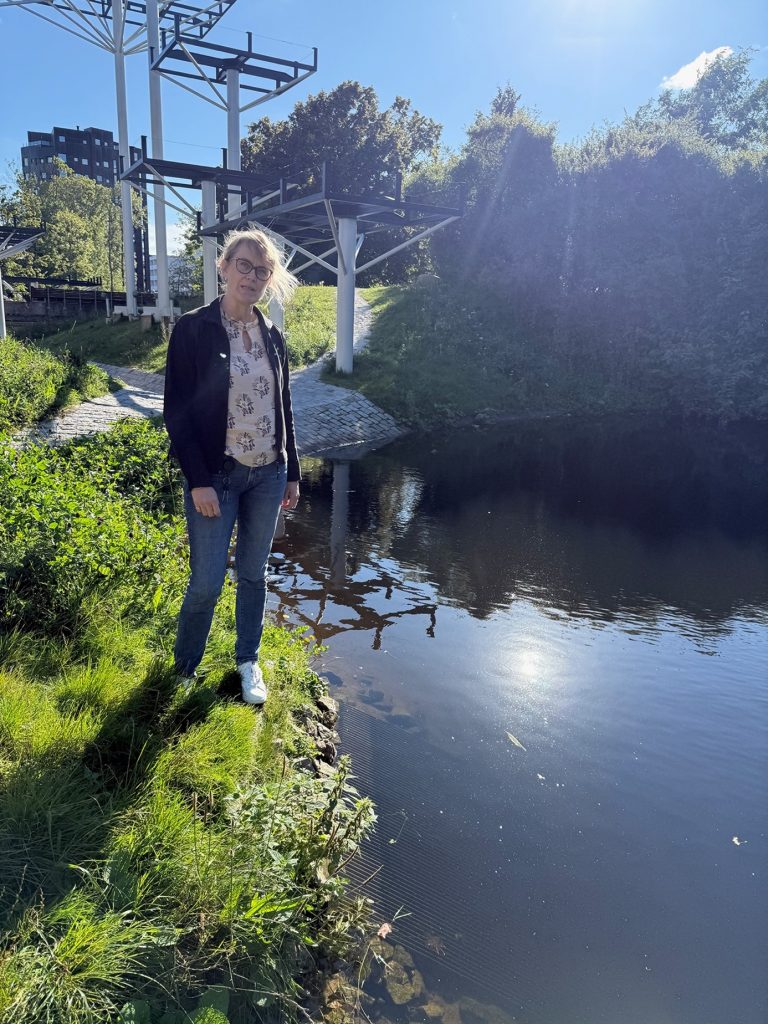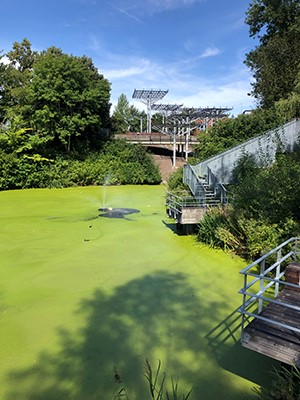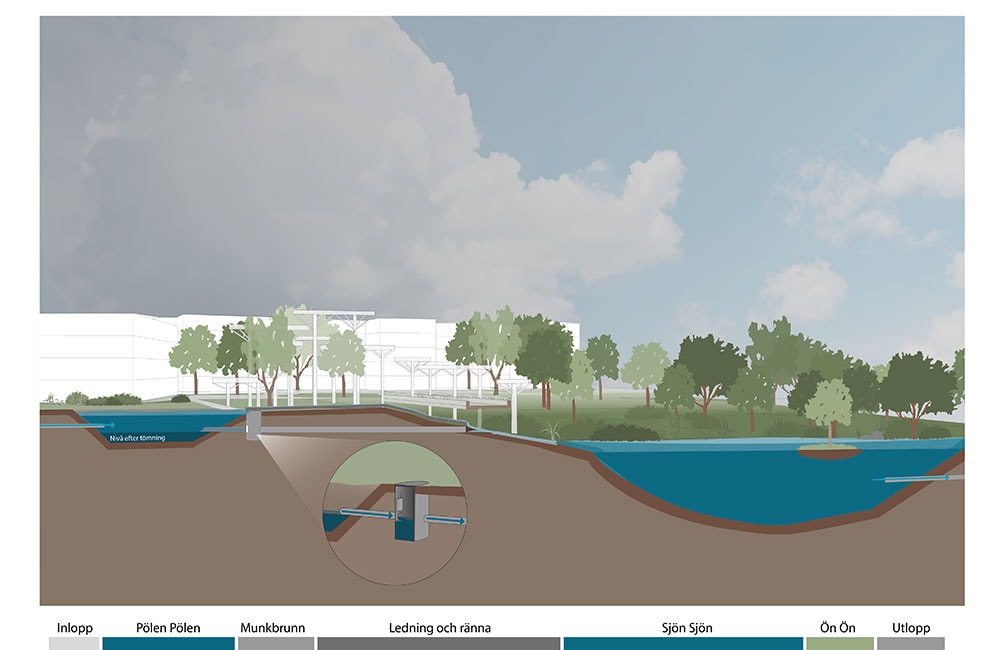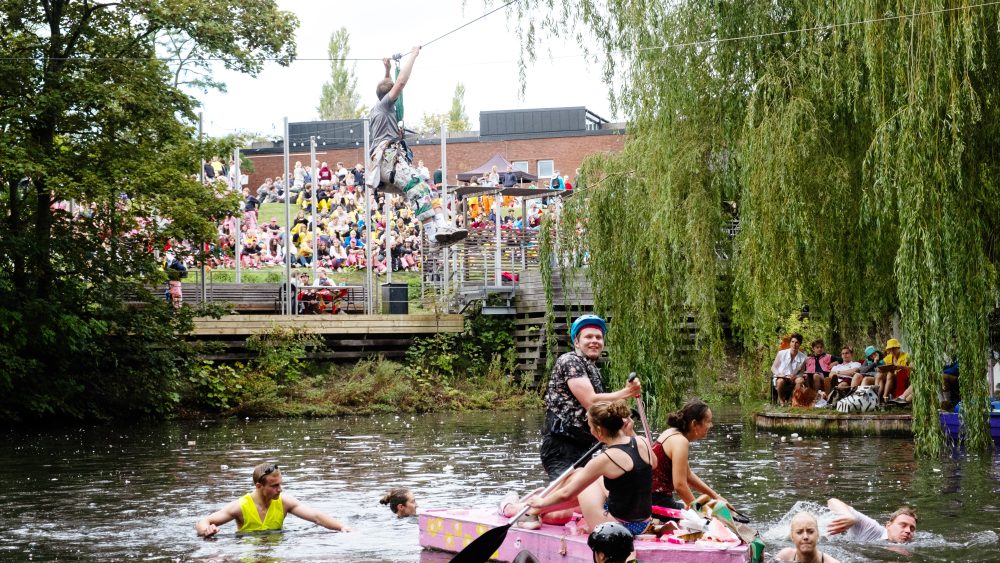Fish deaths, algae growth, bans on swimming and fecal bacteria – now they are just a distant memory. This year, the engineers were able to hold their annual lake battle, the Regatta, on home turf again. This was thanks to LTH’s landlord Akademiska Hus, and their collaboration with VA SYD. But it is also the story of two LTH alumni who, in their professional roles, joined forces to deal with flooding after rain, where vegetation has been replaced by asphalt, and in the process transformed and improved their old campus.
When the area that was to become LTH was being planned, the surroundings were considerably greener than they are today. As more houses were built and the areas around them were paved over, flooding became a noticeable problem – the water simply could not drain away quickly enough.
With even more housing to be built, 500 cubic meters of water needed to be able to be handled during heavy rainfall. This was to prevent the roads around LTH, mainly the intersection of John Ericssons väg and Ole Römers väg, from being flooded.

Åsa Hallbergson is a project manager at Akademiska Hus, the company that owns the land and buildings on the LTH campus.
“The stormwater pipes from the 1960s were too weak because they were laid when the area was mostly fields and greenery. Now we handle storm water from 20 hectares, or 40 football pitches, half of which are hard surfaces,” she explains.
The lake, which together with the pond, are former clay pits from the Pålsjö brickworks, had also been plagued by excessive algae growth, which attracted birds, which in turn defecated and made the water unusable. For a while, it looked more like a golf green than a lake.
As an alumna of LTH’s civil engineering programme, Åsa Hallbergson herself had participated in the Regatta, which is an important part of the students’ initiation. In September, each section builds a vehicle for a naval battle that is then fought during the final weekend of the initiation.

“The lake was never intended for swimming, but the Regatta has symbolic value and is an important tradition,” she says.
In her previous position at Lunds Kommuns Fastighets AB (LKF), Åsa Hallbergson had worked with weather forecasts: before cold spells, the buildings were heated three days in advance.
“And if you can control a house, you should be able to control a level regulation well.”
The plans began to take shape. Åsa Hallbergson picked up the phone and called VA SYD, who jumped at the idea. Research engineer Hanna Nordlander, an alumna of the LTH programme in ecosystems and water resource management, became her partner in crime.
Monk wells and facelifts
In her childhood home of Västergötland, Åsa Hallbergson had an uncle who regulated the level of his pond with something he called a “monk well.” This inspired her to find a solution other than building an above-ground stormwater delay system at LTH. Instead, there is now an ingenious underground construction between the pond Pölen and the lake Sjön, which can divert water to Sjön in advance when heavy rain is expected. Pölen has also undergone a major facelift, with vegetation removed and trash cleared away.

“We have also caught lots of crucian carp,” says Åsa Hallbergson, referring to the fish species that eats zooplankton, thereby promoting the growth of algae and duckweed.
The growth of algae is also inhibited by the increased turnover of water. The environment is improving, and the oxygen content in the water is increasing. Nowadays, pike and perch also swim in the lake Sjön, and they like to eat crucian carp.
“We hope to create an ecosystem here. The Department of Ecology has given us advice and helped us in many ways during the project”, says Åsa Hallbergson.
Twenty-one months after the first phone call, the final inspection was approved. There have been many changes: the channel between Pölen and Sjön has been dug out again and lined with recycled paving stones from the construction of Forum Medicum. Instead of replanting bushes, Akademiska Hus has sown meadow flowers. Gravel paths wind along intuitive walkways. Sometimes the plans were redone during the course of the project. The map had to be adapted to reality instead of the other way around.
“It has turned out very well, thanks to the fact that we have been able to work with responsive, solution-oriented, cooperative contractors who know their stuff.”
Riot-proof design
Åsa Hallbergson notes that it helps to retain a childlike spirit when planning the design of a campus area. The LTH Fountain can now be illuminated with the overall colors of the sections and also TLTH: dark blue, orange, white, red, blue, purple, yellow, pink, blue, turquoise, wine red and green. And the shattered glass left over from the fountain’s former days has now been sifted out of the soil.
“Everything has to be riot-proof, as you do know if you’ve ever been a student yourself.”
When the rain forecasts indicate heavy rainfall, VA SYD can now allow up to 1,000 cubic meters of water to flow from the pond Pölen into the lake Sjön. This means that the capacity is twice as large as originally planned. But that may come in handy, as it is difficult to know exactly where the rain will fall.
Stress test with 20 millimeters of rain in 15 minutes
“The real stress test came on August 2 this year, when 36 millimeters of rain fell in a single day, 20 of which fell in 15 minutes. We passed with flying colors,” says Åsa Hallbergson.
And on 14 September, the students were finally able to celebrate the Regatta on home turf again.
“It wasn’t until the end of the project that we realized that both Hanna at VA SYD and I had been involved in the Regatta, as had another participant, Elin Strand, who holds a Master of Science in Engineering, Surveying and Land Management, and is now responsible for LTH as a property manager at Akademiska Hus.
Text: Evelina Lindén (participant of the Regatta 1991)
See Lundagård’s photos from the Regatta

